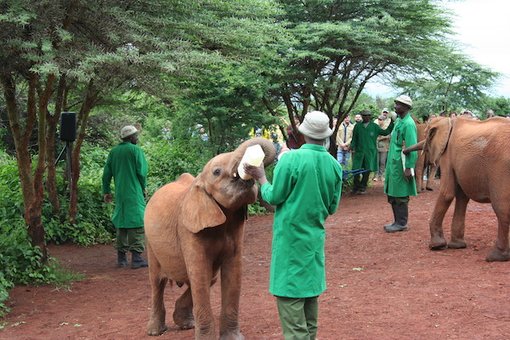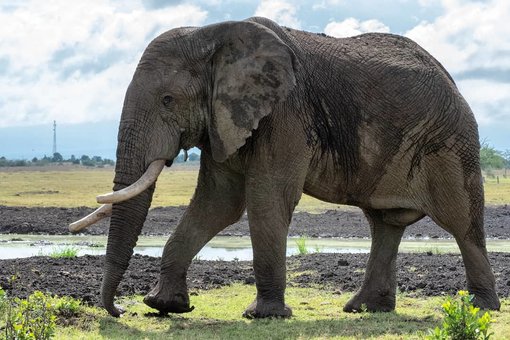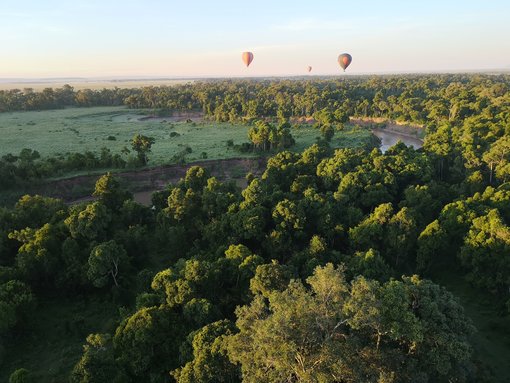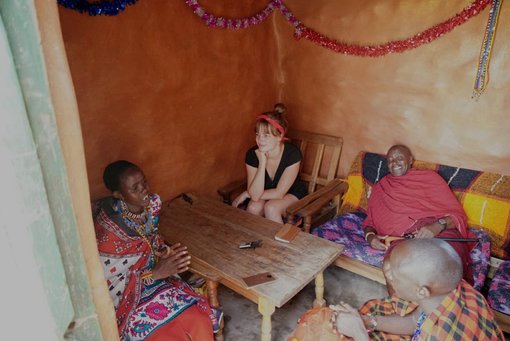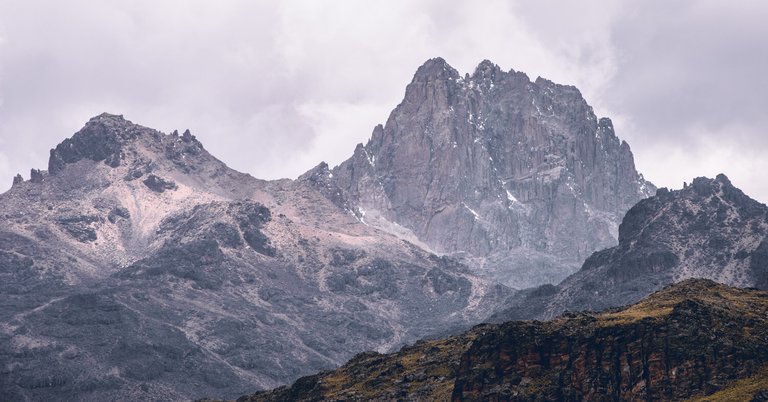
Mount Kenya
1. Introduction
I think it’s safe to say that we like ourselves a challenge. When we told our friends that we were going to climb a mountain in Africa, they immediately asked; “Wow cool, are you going up Mount Kilimanjaro?” But when we told them that we were going to climb the second-highest mountain in Africa instead, it remained silent. “Uhm, what mountain is that exactly?”
Mount Kenya is often forgotten alongside the well-known Roof of Africa: Mount Kilimanjaro. We think this is completely unjustified. In this story, we share our epic experience of the toughest, most challenging hikes we have done so far. Our ascent to Point Lenana at 4.985 meters: the highest peak you can reach without technical climbing. Let us tell you why you should seriously consider climbing Mount Kilimanjaro’s much more authentic ‘little’ brother.
2. The Fellowship of Mount Kenya
It was a hot sunny day and we we’re sitting in the back of a car on our way from Nairobi to the mountain village of Chogoria. We were picked up early by our guide, Kenneth, who checked our luggage thoroughly before we could leave. Good shoes: check. Enough water bottles: check. Warm jacket, gloves and hat: check. Our much-loved old fashioned coffee pot (that we can't live without)... "Nope, sorry, that’s way too heavy.” We tossed it out, cursed some Dutch words, and in about three hours we drove to our destination at the foot of Mount Kenya.
During our quick Kenyan lunch, Kenneth bought us some extra water and food for our trip. Here, we also met our ever-smiling cook, Evan, who would join us on our ascent to prepare our meals. We continued for another hour to Mount Kenya over long and windy dusty gravel roads, straight through the dense forest up the foot of the mountain. Along the way, we pick up the last two of our fellowship; our cheerful porters who barely spoke any English.
Arriving at the gate, we were warned by the rangers for huge forest fires on the mountain. Further, in the distance, we quickly learned clear why.
Large plumes of thick smoke covered the mountains as if it were clouds. Only the high peaks were visible, piercing through the fumes. Our guide Kenneth and the team consulted the park’s rangers whether or not we could continue today. Unfortunately, the fire was spreading too fast and camping on the mountain would be extremely dangerous. However, we could try again the next day.
We were disappointed, but also glad Kenneth took our safety seriously. We stayed for the night in a Kenyan banda at the rangers camp at 3.000 meters, where Evan prepared a star-worthy meal.
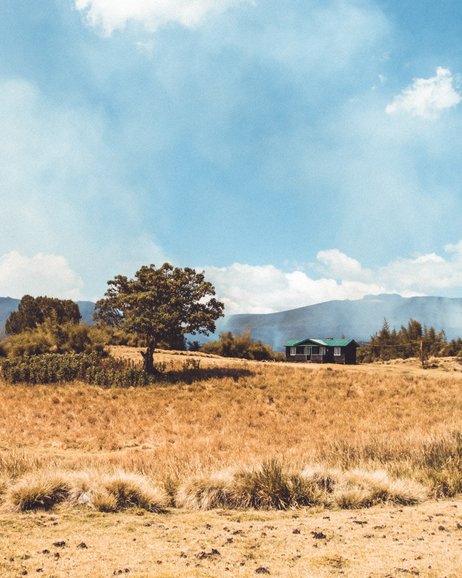
Smoke on the mountain
3. The Start of Our Hike
The next morning we woke up early, but our team was already preparing for our ascend. They checked with the ranger and the fires seemed to be ‘under control’. At least, enough for us to go. We munched down a hearty breakfast and took off to the colossal snowy peaks of Mount Kenya.
The 14-kilometre hike to our first campsite would take us through a wide variety of ever-changing landscapes. Dry grasslands, lush forests and eventually, dark scorched fields. It was almost like walking on the burned surface of a foreign planet. The scenery became more and more dramatic as we ventured on.
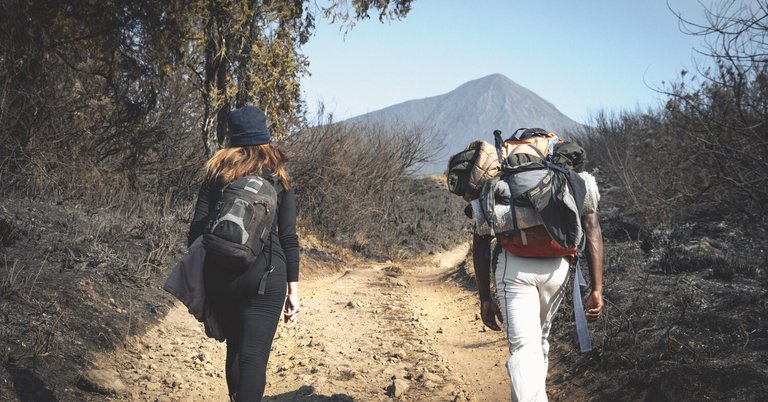
Off we go
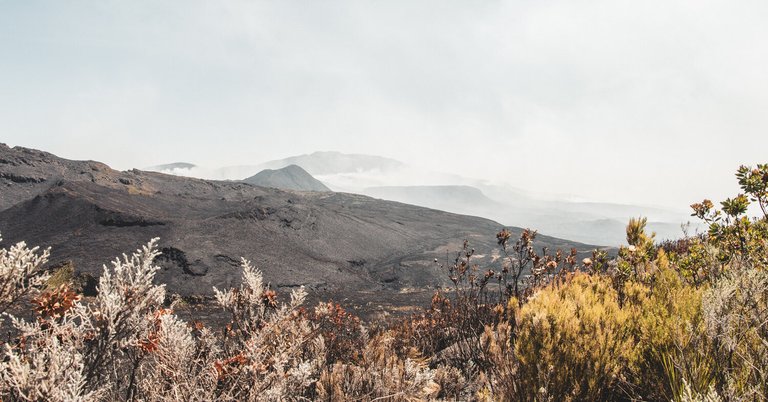
Burned mountain
The elevation quickly caught up with us as we passed the 4000-meter line, making it harder to breathe. While we were struggling with every step, feeling as if we could collapse any minute now, our porters and Evan happily skipped past us. When we finally arrived at Mintos hut at 4.300 meters, they had already set up our tent, made us some lemon tea and prepared our food.
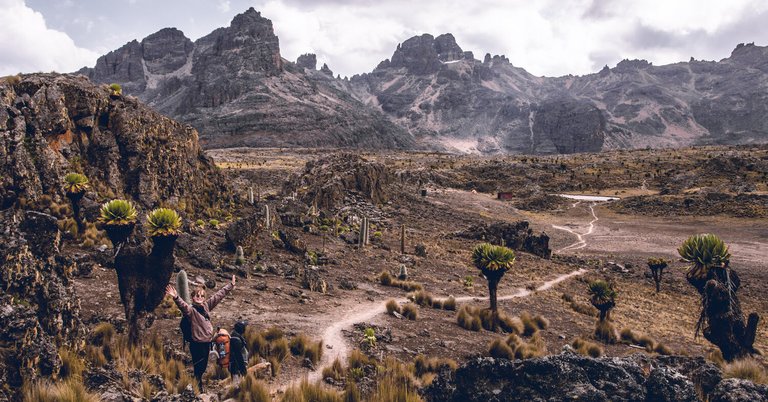
Mintos hut Mount Kenya
Surprisingly enough, after the long hike and climb, we were not hungry at all: a clear consequence of altitude sickness. Although we felt fine (except for a lingering headache), everything seemed to cost us a lot of energy. After our early dinner, we crawled into our little tent and it started getting extremely cold. We put on all the clothes we had with us (thermal underwear, shirt, sweater, jacket, hat and gloves), but it still felt chilly sleeping in -10 degrees Celsius.
4. To The Summit
The alarm clock abruptly wakes us from our light snooze around 2:30 AM. The stars were bright and our tent and water bottles were frozen solid. Despite feeling quite uncomfortable at this hour of the day, we were very excited and had positive vibes to get to the summit and see the sunrise. We put on our headlamps and followed Kenneth’s footsteps into the dark night.
The first two hours upwards were quite tough but were going fine. But then the slopes got steeper and more difficult by the minute. Walking in silence, in the freezing cold, in the middle of the night we suddenly got that inevitable feeling of ‘why am I doing this again?’.
Every step became harder and the track seemed never-ending. Kenneth, at this point, wasn’t off much help either, as every time we asked him how much farther we had to go, he responded with: ‘‘almost there’’. We stepped on, slowly but steadily, and the icy winds became very harsh on our face, hands and bodies.
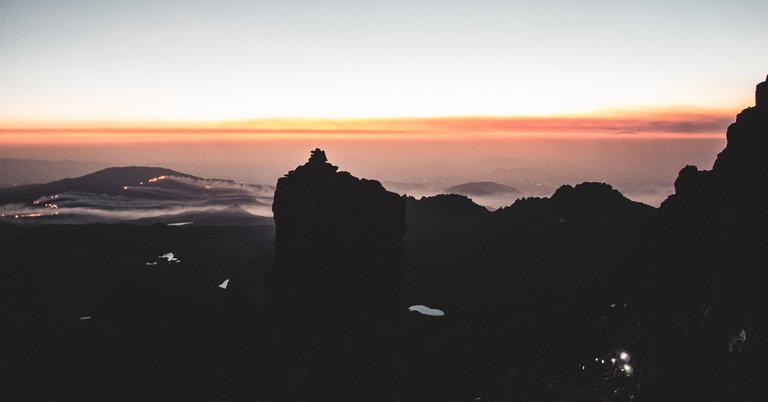
Sunrise and headlamps
We recall it was around 6:00 AM that we suddenly saw other climbers. Small headlamps appeared from all directions, heading for the summit.
This last part was, well… brutal. Co-climbers encouraged each other to go on for the last few meters and assisted them to the top. This gave us hope. In the dawn of the morning, we think we saw a flag. That must be the summit, or is it? Is it even a flag? The exhaustion and altitude sickness had certainly made us go insane.
The last part was very steep and incredibly tough. We climbed a frozen ladder. Then, suddenly, we were there. We couldn’t believe that we were actually standing on the summit of Mount Kenya! And as if it was a sign from above, the sun started to rise over this unforgettable place and revealed all that was dark before: dozens of scattered mountain lakes, a huge glacier and the giant 5.199 peak of Mount Kenya right next to us.
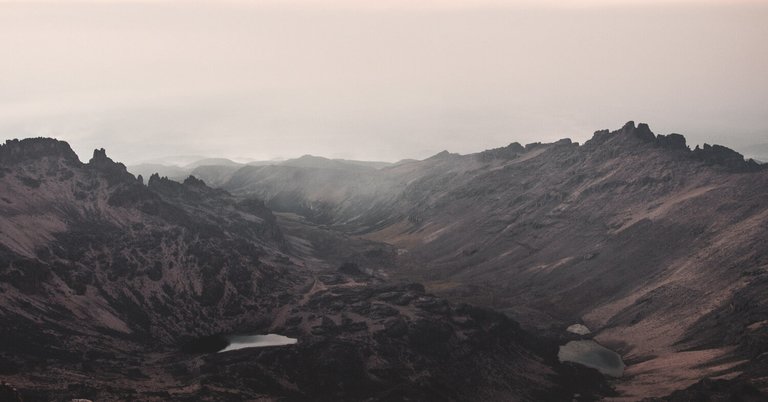
Mount Kenya view
We both cried. From physical exhaustion, relief and of all the other emotions we experienced on this epic journey. Totally broken, but also grateful that we could experience this special moment, together. We took some pictures with watery eyes by the famous sign at 4.985 meters Lenana Summit. Truly a once in a lifetime experience!
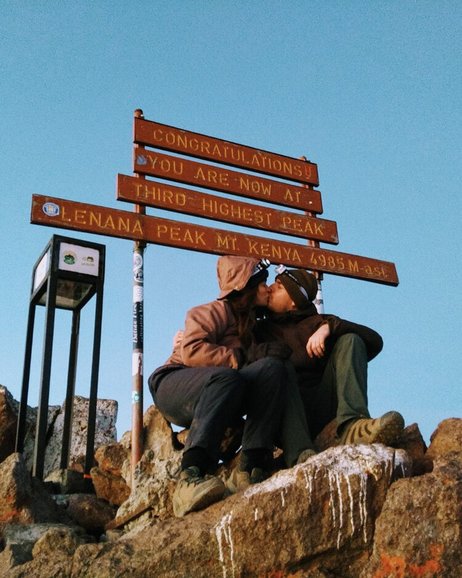
The Summit
5. The Long Way Back
While we sat there in silence, staring at the rising sun over the horizon, we were woken up from our daydream by Kenneth. It was time to go down again.
It was still a very tough journey back to Mintos. The loose gravel on the steep slope (read: jelly legs) make it difficult to keep a grip. So we slipped down, clamping on big rocks and stones until the landscape finally became less rocky and walkable again.
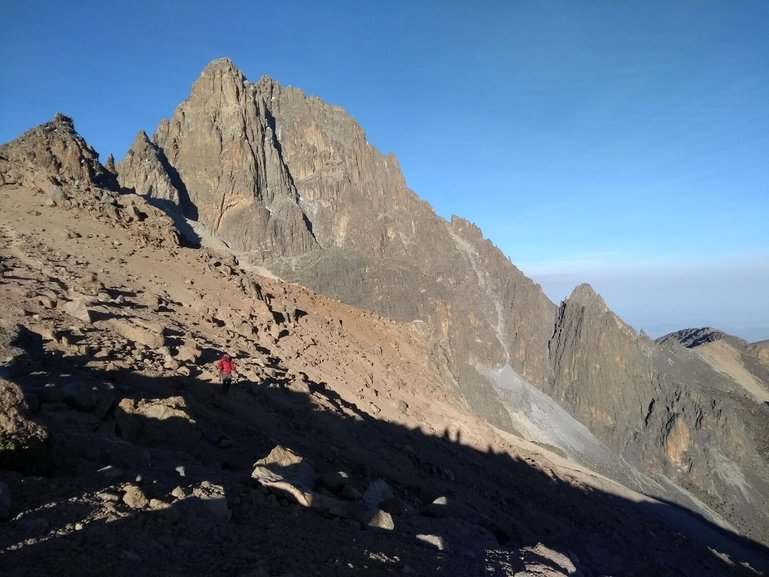
Mount Kenya Summit
At Mintos, we are congratulated by Evan and the team and were treated to a delicious well-deserved breakfast. But we didn’t have much time to relax. At 11:00 AM sharp we were back on our shoes, feeling ‘fresh’ to walk all the way back to the banda at the rangers office. We won't lie: walking almost 18 kilometres down was hard. Really, really hard. But the warm welcome we received from the team and some fellow hikers as we arrived made the tiredness disappear instantly.
We will never forget this incredible experience. We would like to thank Kenneth, Evan and his team for making this possible.
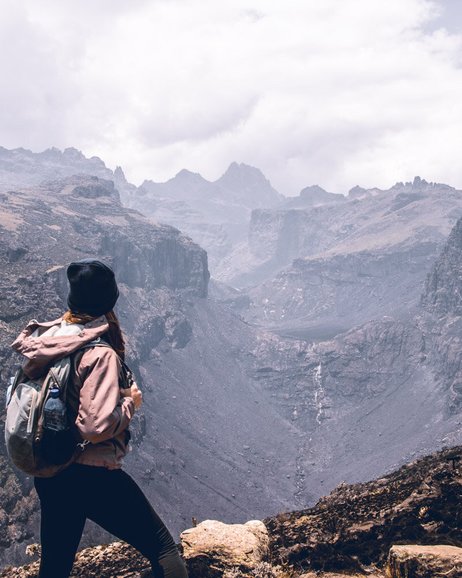
Mount Kenya in the distance
6. Mount Kenya Facts
Mount Kenya may not the Roof of Africa, but certainly is the Roof of Kenya. With a height of 5.199 meters, this is the highest mountain (actually a stratovolcano) in Africa right behind Mount Kilimanjaro. The highest peaks are Batian (5.199m), Nelion (5.188m) and Point Lenana (4.985m), of which Batian and Nelion can only be reached through technical climbing by very experienced mountain climbers. Point Lenana is the ‘summit’ for hikers.
There are several glaciers on Mount Kenya, which are unfortunately disappearing due to global warming. Lewis Glacier is the largest and most famous and is clearly visible from Point Lenana. The temperature and weather on Mount Kenya can vary enormously, depending on the altitude and the time of day.
At the foot of the mountain, at around 3.000 meters, the temperature fluctuates between 10 degrees Celsius at night and 20 degrees Celsius during the day; the top is drastically colder with temperatures between -15 and +8 degrees Celsius! The days generally start clear and sunny. Clouds usually appear later during the day which brings a higher chance of precipitation. That’s why it’s recommended to climb the summit in the early morning.
Mount Kenya knows two wet seasons (March to June and October to December) in which the most precipitation (as snow) falls. Therefore, the best months to hike are the dry seasons (the remaining months).
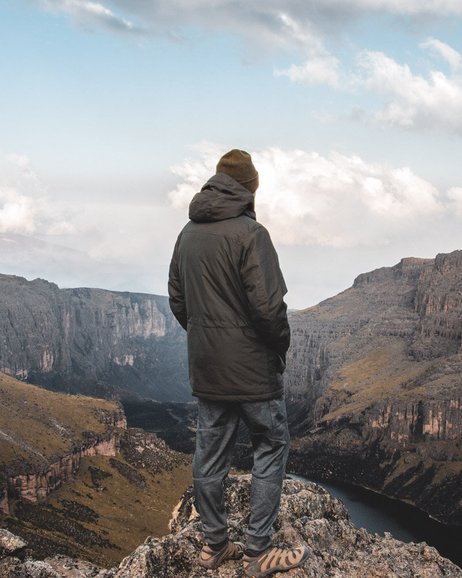
Mountain and lake view
7. Costs & Where to Book
We climbed it with local guide Kenneth and his team that Simone knew through her job in Kenya. Booking directly with the guide is something we can highly recommend to ensure our money goes directly to the team, their families and the local community. We would recommend checking out local Facebook pages to explore your options on different parties you can go with.
Another good and local guide is John Mukarama. The costs for climbing Mount Kenya with a guide, two porters and a cook are average around $500,- to $700,- US Dollars for 3-4 days. Don’t forget that tipping is a big part of African culture, and therefor calculate beforehand how much tipping is provided. The best is to bring that amount in cash so you can give this directly to each and every team member. A good guideline is around 20-25$ per day for the guide, 15-20$ per day for the cook and around 10$ per day per porter.
You are allowed to climb Mount Kenya without a team (meaning that you will have to carry ALL your gear, food and water yourself). You will have to register with the park rangers at Mt. Kenya Lodge and pay a fee, depending on how many days you are planning to stay here. The fees go directly to the preservation of the National Park, so please pay them!











